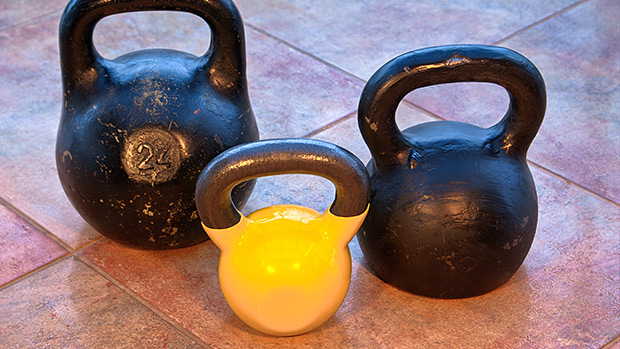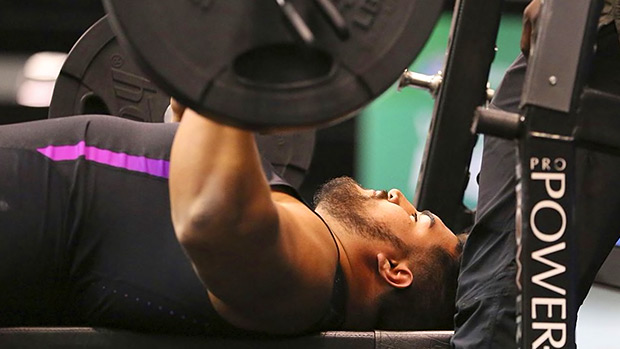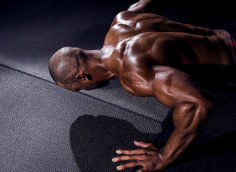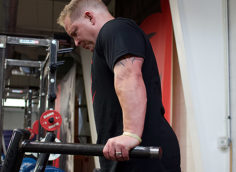There are 1001 things you could do before your bench press workout to ramp up performance, improve movement capacity, and manage that dodgy shoulder. But all those foam rolling drills, mobilizations, potentiation exercises, and mobility techniques can get overwhelming.
So, what's best? Well, first let's talk about what's NOT going to help you – summadees. As in some-of-these. "I don't know what to do so I'll just do summadees." That's typically a few random arm swings and circles.
Doing "summadees" is the equivalent of doing nothing at all. Let's fix this today. And don't worry, it won't take up half of your training time.
If you have to pick one drill to do before your upper-body pressing, it should be the bottoms-up kettlebell press or BUP.
Any variation will do – standing, staggered, half-kneeling, tall-kneeling, one-armed, or two-armed. You can mix them up. The important thing is that you do it, you master it, and you monitor it.
A half-kneeling position works particularly well though. It helps you open up the hips and get some lower-body activation at the same time. Here are a few key technique tips:
- Use a pad for your back knee to help raise your hips to level, as well as provide a little comfort.
- Assume a 90/90 position with the front and back knee at 90 degrees.
- Good technique starts from the floor up. Front foot should be planted and stable, and the back foot either dorsiflexed or laces down.
- Brace your abs and engage your glutes. Crack a walnut between those cheeks! A slight posterior pelvic tilt or "cock-up" position should be encouraged.
- Initially, start with a lighter kettlebell – 10 percent of your bench press 1RM is a good start.
- Grip the kettlebell in the bottoms-up position as hard as you can. No chalk or pink lifting gloves allowed here. This needs to be raw.
- Keep the kettlebell in a neutral-grip position as you press up overhead. Keep the core, glutes, arms, and grip maximally engaged and dominate the kettlebell.
- Maintain focus. Close your eyes if you must, but that kettlebell should be your only thought.
- Maintain control of the bottoms-up position as you take your shoulder through a full range of motion overhead press.
- A few sets of 8-15 reps at the start of your workout should set you up for pressing success.

The BUP teaches you the principle of irradiation. By gripping the kettlebell hard to stabilize its bottoms-up position, the rest of your arm needs to work hard too. This increased tension in your arm irradiates to create more stability in the shoulder.
The overhead position will also provide an additional core challenge. Like your tense arm promoting shoulder stability, the irradiation principle and your tense torso will do the same thing to your shoulder and enhance the effect.
If you think a BUP will only prepare your shoulder for overhead pressing (because it's technically an overhead press after all) then you're wrong.
While it's true that the BUP helps you find the right groove for pressing overhead, what's going on inside the shoulder will have a massive transfer to any and all pressing exercises.
I've also found the BUP to be a great morning "wake-up" tool for those with long-term shoulder pain. A few sets of these bad boys with a moderately challenging weight and pain can sometimes disappear for the entirety of that day. This can be life-changing.
After a short period of consistent use, your ability to perform a BUP can be a good indicator of your overall readiness to train and lift heavy on any given day. If you're as loose as a noodle when performing the BUP then it might not be a day to try and set some personal bests.
If you find that you were dominating a 12 kg BUP last week and today you can't get a hold of it, then it's a good idea to do a more extensive warm-up before hitting the heavy stuff.
You can use a BUP to monitor any strength asymmetries, too. If you're seeing a left-to-right difference in strength or control, then you've got something you should work on. Performing an extra few sets on the weaker side is a good place to start.
Use this drill to monitor early signs of overtraining. I mentioned how it's a good sign of workout readiness, but if this lack of readiness becomes a pattern (more than three workouts in a row) then it's a sure sign there's something more going on.
Signs of overtraining can differ depending on whether you're overtraining via volume or overtraining via intensity. One will bring about signs and symptoms associated with CNS fatigue, the other more muscular fatigue. One will cause you to lose your appetite and have trouble sleeping; the other will cause you to eat and sleep at every opportunity you can find.
A BUP can be a practical tool to monitor overtraining for the CNS, typically as a result of intensity. After regular use and qualitative assessment of your "normal" ability, a continued reduction in BUP performance might be an early sign that you should take a non-scheduled de-load week.





